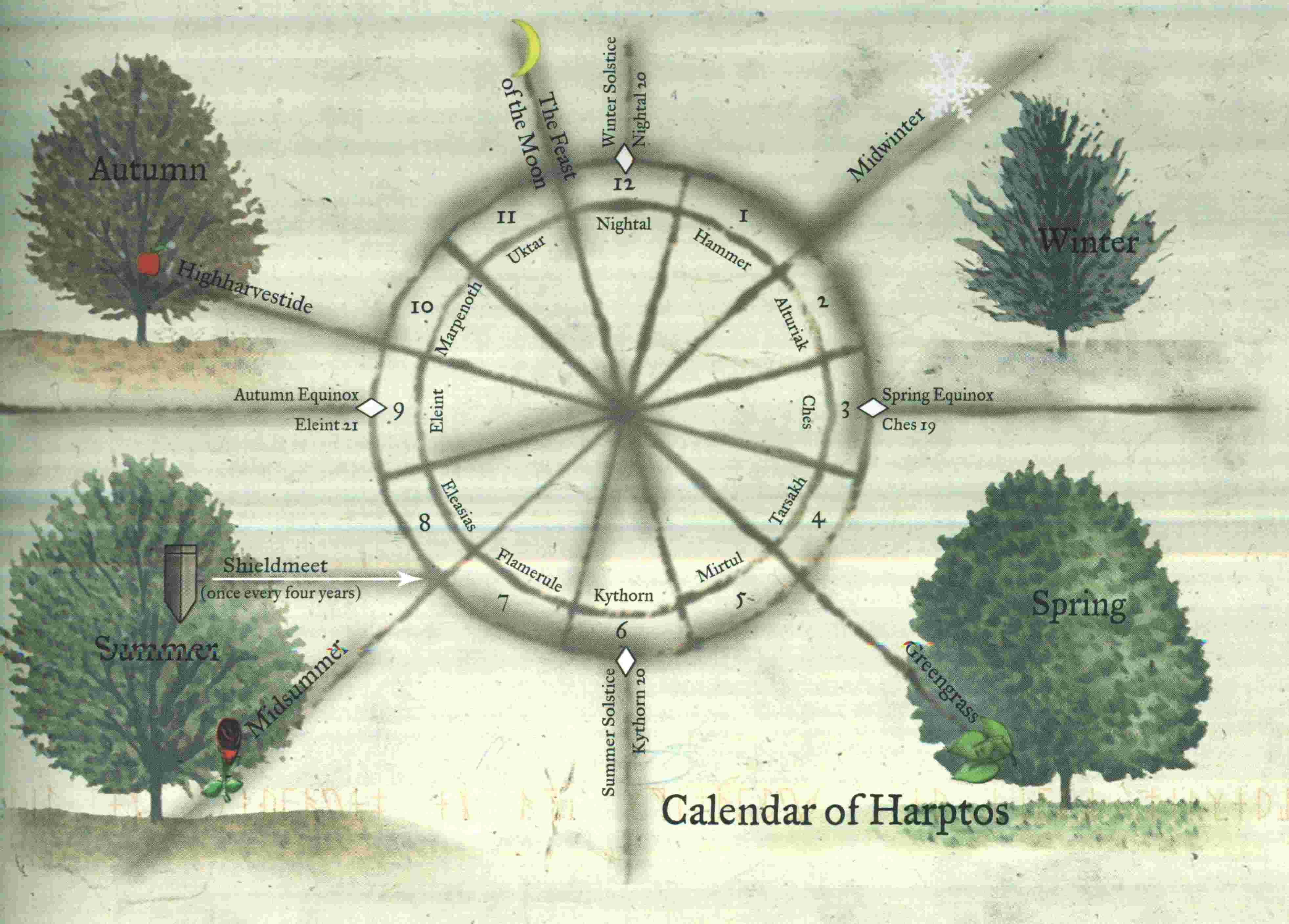Day and Night
Faerûn's days are 24 hours long, divided into night and day by the rising and setting of the sun. In some southern lands, the length of the night does not vary much with the seasons, and 12 hours of light and 12 of dark is the rule year-round. In the north, the days are markedly longer in the summer and shorter in winter.Ten days comprise a Faerûnian week, also known as a tenday or, less commonly, a ride. The individual days of the tenday do not have names. Instead, they're referred to by number: first-day, second-day, and so on. Most folk start counting using their thumb as first-day, but halflings are famous for using their pinkies to count first-day, so much so that the phrase "counting like a halfling" means that someone is being different just to be difficult.
The Hours of the Day
Timepieces are very rare, and most people break up the day into ten large slices - dawn, morning, highsun (or noon), afternoon, dusk, sunset, evening, midnight, moondark (or night's heart), and night's end.In large cities, the tolling of temple bells replace the more casual accounting of the day's passage. Several major faiths attempt to measure time more accurately. The priests of Gond treasure their mechanical clocks and delight in sounding them for all to hear. Lathanderians assign acolytes to watch sundials, carefully adjusted by years of observation of the sun's movements in the sky. Traditionally, the hours are numbered 1 to 12 twice, and the bells sound once for each hour on the hour. "Twelve bells" is virtually interchangeable with "midnight" or "highsun", depending on the context.
The Calendar of Harptos
Most of Faerûn uses the Calendar of Harptos, named after the long dead wizard who invented it.Each year of 365 days is divided into 12 months of 30 days, and each month is divided into three tendays. Five special days fall between the months. These annual holidays mark the seasons or the changing of the seasons.
The Calendar of Harptos Month Name Common Name 1 Hammer Deepwinter Annual Holiday: Midwinter 2 Alturiak The Claw of Winter 3 Ches The Claw of the Sunsets 4 Tarsakh The Claw of the Storms Annual Holiday: Greengrass 5 Mirtul The Melting 6 Kythorn The Time of Flowers 7 Flamerule Summertide Annual Holiday: Midsummer 8 Eleasis Highsun 9 Eleint The Fading Annual Holiday: Highharvestide 10 Marponeth Leaffall 11 Uktar The Rotting Annual Holiday: The Feast of the Moon 12 Nightal The Drawing Down
The Calendar of Harptos - Picture

Seasonal Festivals
Five times a year the annual holidays are observed as festivals and days of rest in almost every civilized land. Each seasonal festival is celebrated differently, according to the traditions of the land and the particular holiday.Midwinter: Nobles and monarchs greet the halfway point of winter with a feast day they call the High Festival of Winter. Traditionally it's the best day to make or renew alliances. The common folk enjoy the celebration a bit less - among them it's called Deadwinter Day, noted mainly as the halfway point of winter, with hard times still to come. Greengrass: The official beginning of spring is a day of peace and rejoicing. Even if snow still covers the ground, clerics, nobles, and wealthy folk make a point of bringing out flowers grown in special rooms within temples and castles. They distribute the flowers among the people, who wear them or cast them upon the ground as bright offerings to the deities who summon the summer. Midsummer: Midsummer night is a time of feasting and music and love. Acquaintances turn into dalliances, courtships turn into betrothals, and the deities themselves take a part by ensuring good weather for feasting and frolicking in the woods. Bad weather on this special night is taken as an omen of extremely ill fortune to come. Highharvestide: This holiday of feasting to celebrate the autumn harvest also marks a time of journeys. Emissaries, pilgrims, adventurers, and everyone else eager to make speed traditionally leave on their journeys the following day - before the worst of the mud clogs the tracks and the rain freezes into snow. The Feast of the Moon: The Feast of the Moon celebrates ancestors and the honored dead. Stories of ancestors' exploits mix with the legends of deities until it's hard to tell one from the other. Shieldmeet
Once every four years, Shieldmeet is added to the Faerûnian calendar as a "leap day" immediately following Midsummer night. Shieldmeet is a day of open council between the people and their rulers. It is a day for making or renewing pacts and for proving oneself in tournaments. Those not seeking advancement treat the elite's tournaments, duels, and trials of magical prowess as welcome additions to the holiday's theatrical and musical entertainments.In the Dales, a great Shieldmeet celebration is planned in the town of Essembra in Battledale this year. Other regions of Faerûn have planned festivals ranging from the somber to the outrageous.